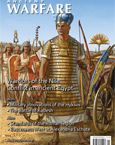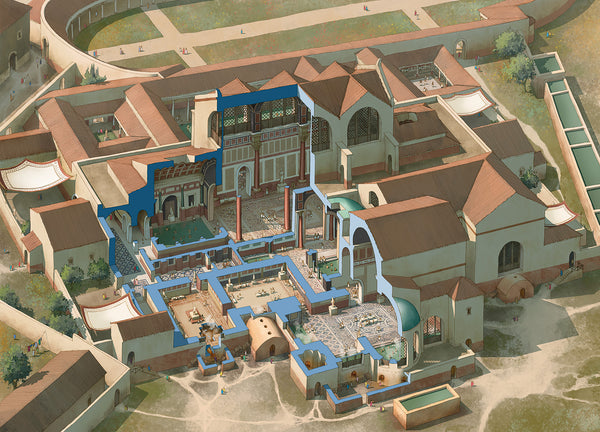40 issues of Ancient Warfare
The latest issue of Ancient Warfare, issue VII.6, is off to the printer’s. The theme for this issue is Marcus Aurelius, whom I have dubbed a “reluctant warlord”, inspired by the original title of Robert Heiligers’s introduction to the issue (the “stoic warlord”). I am very happy with how it turned out and it is, at present, another one of my personal favourites of the issues that I have done as editor, right alongside issue VII.1, on ancient Egypt. I look forward to reading the comments of readers once it returns from the printer’s and is sent to subscribers and stores, towards the end of this month.
I started working at Karwansaray Publishers in October of 2012. Before that, I had written some articles and I also managed to get a book deal for what later became Henchmen of Ares. The first issue I did was VI.5, on the armies of Diocletian. Issue VII.6 is the eighth issue that I have done as editor of Ancient Warfare, after having followed in Jasper Oorthuys’s footsteps. The forthcoming issue is the last of the seventh volume and the fortieth issue overall to appear since the magazine’s inception in 2007.
A retrospective

Forty issues of Ancient Warfare is quite remarkable. This comes down to some 2000 pages’ worth of information on ancient military matters, not counting the various specials that we have done over the years. By now, all of the issues taken together provide a wealth of information on warfare in the ancient world, from 3000 BC to the end of the Classical age. The first issue of volume IX, which is still quite a way off, will be on the fall of the Roman Empire in the west, by which point we can truly say that Ancient Warfare has covered the ancient world throughout much of its spectrum.
The earliest organized warfare was the subject for issue II.5, on warfare in the ancient Near East, featuring articles on, for example, Mesopotamian warfare, Assyrian siege techniques, and the Battle of Megiddo. Warfare during the Middle and New Kingdom periods of ancient Egypt were the subject of issue VII.1. The end of the Bronze Age is the subject of issue IV.4. The Assyrian war-machine of the first half of the first millennium BC was the theme for issue V.4.
The Greeks

In the history of ancient warfare, Greece always features prominently. Issue VI.6 focused on warfare in Archaic Greece, a subject close to my own heart. Issue VII.2 broadened the scope a bit by focusing on the struggles between Greeks and Carthaginians over control of the island of Sicily. Issue VII.5, the first issue to feature a completely new layout, was on the so-called March of the Ten Thousand, made famous by Xenophon’s Anabasis.
While Alexander the Great himself was never the subject of a themed issue, there have appeared numerous articles that deal with aspects of his wars of conquest, such as Duncan Campbell’s article on the Battle at the Granicus in issue VII.2. There have also been a number of issues specifically devoted to some of his successors, most notably issue III.2. Issue IV.6 likewise is devoted to wars of, and wars between, the Hellenistic kingdoms. Issue V.6 deals with elite units of the Hellenistic armies. Alexander’s kinsman, Pyrrhus of Epirus, was the subject of issue VI.4.
The Romans
Ancient Warfare was originally born on the RomanArmyTalk Forum, and as a result there has always been a lot of interest in the Roman military machine. Some issues dealt with the early history of Rome and Italy. Issue IV.1 dealt specifically with the topic of Italy before the Roman conquest, while issue VII.3 moved the story forwards in time and focused on Rome’s early struggles in asserting its domination on the peninsula.

For the era of the developed Republic, issue I.4 dealt with the Roman conquest of Spain. In the military history of Rome, no name perhaps is more important than that of Gaius Marius, and it comes no surprise that he and his reforms, at the end of the second century BC, are the topic of issue V.1. The campaigns of Julius Caesar were the subject of issue II.4, although the Battle of Alesia wasn’t featured until our Celtic issue, VI.6.
Various issues have dealt with military aspects of the Early Roman Empire. The campaigns of Agricola, who was one of Rome’s most successful commanders in Britain, were the subject of the magazine’s very first issue. The navy of imperial Rome was the theme for issue V.5. Issue VI.2 dealt with the Dacian Wars.
There have also been a number of issues dealing specifically with the enemies of Rome. The Celtic enemies of Rome were the subject of issue VI.6, featuring articles on the revolt of Boudicca and the Battle of Alesia. Issue III.4 was on the Barcids, while issue III.5 dealt with the Parthians. Issue V.3 focused on Rome’s conflicts with the Sassanid Empire.
The age of the later Roman Empire sort of starts with the Crisis of the Third Century, during which Rome saw the rapid rise and fall of a large number of soldier-emperors in a comparatively short span of time. The Crisis itself was the subject of issue II.6. Diocletian tried to restore order to the Empire, as explained in issue VI.5. The latter stages of the Roman Empire are the topic of issue IV.3, which deal with the campaigns of Belisarius.
Other themes

Every volume usually features two Greek-themed issues, two Roman, one “early” or non-Graeco-Roman themed issue, and one issue with a “diachronic” theme. For volume I, which featured only four issues, this scheme hadn’t yet emerged. It had two diachronic issues, one on everyday life in camp and on campaign and another on defensive armour. Issue II.1 was on light infantry troops. That same volume also featured an issue on victory and defeat. Issue III.6 dealt with battlefield communications.
Some issues take a broader look at particular phenomena. Issue II.3 focused on the trireme, while issue III.1 looked at mercenaries in the ancient world. Issue V.2 deals withbodyguards. Another favourite of mine is issue III.3, on “Classical heroes”, and I’m not just saying that because I wrote a piece on Homer for it. Issue IV.2, on blockade and assault, takes a broad view on sieges in the ancient world, which were probably more common than pitched battles. Issue IV.5 dealt with the connection between warfare and religion, a very fashionable topic. Issue VI.3 focused on cavalry in the ancient world. Finally, issue VII.4 dealt with logistics and the army train.
Ancient Warfare Specials
The Specials provide in-depth looks at some particular aspects of ancient warfare. The 2009-special deals with the Varian Disaster, the Battle at Teutoburg Forest. The 2010-special focused on the Roman imperial centuria. The 2011-issue dealt with the Battle of Marathon (490 BC), when the Athenians defeated the Persians.
Since 2012, the special issues have been transformed into larger, hardcover books. Edge of Empire(2012), written by Jona Lendering and Arjen Bosman, deals with the Roman occupation of the Low Countries. My own Henchmen of Ares (2013) focuses on warfare in Early Greece, from the Mycenaean Bronze Age down to the Persian Wars.
The future
40 issues of Ancient Warfare taken together provide a vast reference library on warfare in the ancient world. We could not have done it without the contributions of our writers, nor without the help of our pool of talented illustrators, who never fail to bring the ancient world to life. Of course, we would never have been able to publish seven volumes without our readers! Thanks to you all for enablingAncient Warfare to continue to grow and prosper.
The future looks bright for the magazine. All of the themes for the coming issues of volume VIII have already been planned out. Issue VII.1 will deal with traitors, deserters and defectors in the ancient world. Issues VIII.2 focused on the struggles of the Ionian Greeks, from the Archaic period down to Alexander. Issue VIII.3 is on horsemen of steppes, issue VIII.4 on the Seleucid Empire, VIII.5 on the Judaean Wars, and issue VIII.6 on the Roman conquest of Greece. Have a look at the editorial planfor further details.
We continue to fill in the blanks and provide ever more information on warfare in the ancient world, and we plan to continue doing this for many more years to come.

